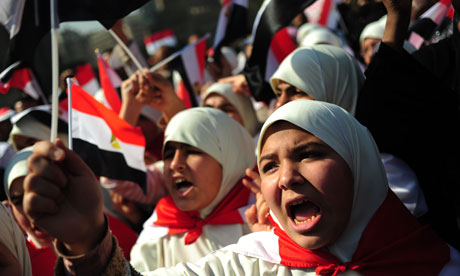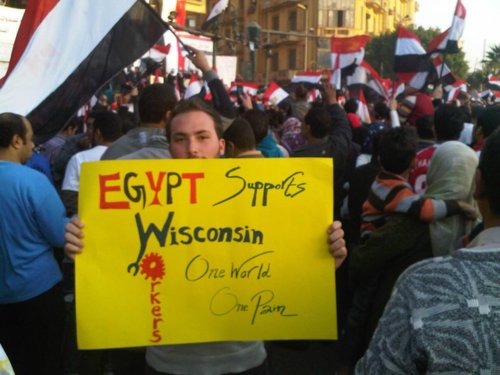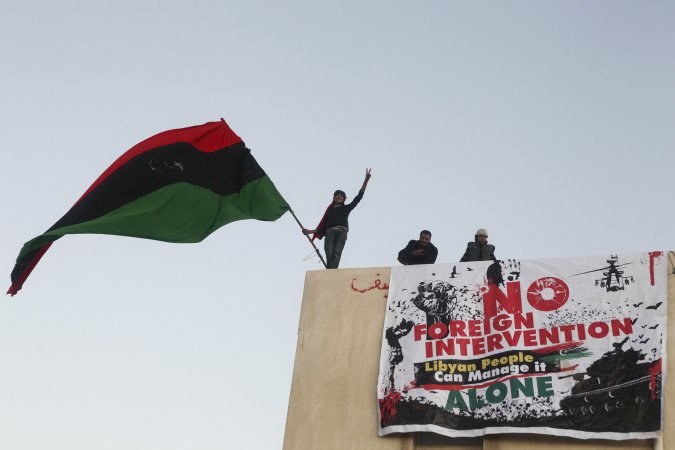John Edmundson, Workers Party education officer, Christchurch
 The biggest political story so far in 2011 has been the upsurge in mass protest in the Middle East and North Africa and the changes in government that have already been ushered in in Tunisia and Egypt. Massive demonstrations have shaken Yemen, Bahrain, Libya, Algeria and Jordan. Throughout the Arabic-speaking world, mass movements have emerged, seemingly from nowhere, to challenge long established dictatorial, and largely US-allied regimes that had seemed impervious to change and unthreatened by an apparently passive, depoliticized population. In Libya, civil war has broken out between the rebels, a mix of hastily armed civilians and elements of the army and air force that defected to the revolt, and those military and militia forces that have remained loyal to Libyan leader Col. Muammar Gaddafi. Subsequently of course, Western intervention, in the form of bombardments and airstrikes, has ensued under the pretext of saving civilian lives.
The biggest political story so far in 2011 has been the upsurge in mass protest in the Middle East and North Africa and the changes in government that have already been ushered in in Tunisia and Egypt. Massive demonstrations have shaken Yemen, Bahrain, Libya, Algeria and Jordan. Throughout the Arabic-speaking world, mass movements have emerged, seemingly from nowhere, to challenge long established dictatorial, and largely US-allied regimes that had seemed impervious to change and unthreatened by an apparently passive, depoliticized population. In Libya, civil war has broken out between the rebels, a mix of hastily armed civilians and elements of the army and air force that defected to the revolt, and those military and militia forces that have remained loyal to Libyan leader Col. Muammar Gaddafi. Subsequently of course, Western intervention, in the form of bombardments and airstrikes, has ensued under the pretext of saving civilian lives.
So where did these movements come from, how did they arise so suddenly and what potential significance do they have for the region and for revolutionary movements around the world? Many commentators reacted to the massive demonstrations, especially those in Egypt, with surprise, having long regarded Egypt as one of the most stable countries in the Middle East. US administration insiders cited Libya and Iran as much more likely contenders for popular uprisings. Iran of course has seen a renewal of its popular movement and Libya too was soon to be gripped by protest and violent military repression, but how did the pundits get it so wrong about such dependable US allies as Egypt, Bahrain and Yemen? The situation is changing by the day, or in some cases, by the hour, so any attempt to provide up to date commentary would be futile, but an analysis of the background to these events and their potential significance is possible.
The initial events in this upsurge in anti-government protest began in Tunisia, long considered a secure US ally. Tunisia is not an oil rich country, although it does have some natural gas resources and was a stable country with a burgeoning tourism industry, based on sandy Mediterranean beaches and Roman and Carthaginian ruins. It was also a popular destination for film makers, with both the desert scenes in Star Wars and sections of Monty Python’s The Life of Brian filmed in its stark but beautiful desert landscapes. But behind the picture postcard façade was an equally stark and unforgiving reality – the relentless attacks of capitalist restructuring. Youth unemployment was as high as fifty percent in some parts of the country. Rapidly increasing prices for basic food items combined with poor job opportunities left the young people of Tunisia in particular facing a bleak future, compounded by heightened expectations brought about through higher education.
The spark came with the death of a young Tunisian man, Mohamed Bouazizi, who burned himself in a despairing act of anger after he was harassed once too often by the police in his home town of Sidi Bouzid. Bouazizi had been unable to find appropriate work despite a university qualification. Angry Tunisians, repressed by decades of rule by President Zine Al Abadine Ben Ali, reacted by pouring into the streets demanding justice. Before long the demonstrations were calling for the overthrow of Ben Ali and his entire ruling party. When the army declared that, not only would it not fire on the protesters, but that it would protect them from the much hated and feared police and security forces, Ben Ali’s fate was effectively sealed. Desperate bids to cling onto power by claiming that the alternative was an Al Qaeda regime and by offering to appoint a new government were met with scorn by an increasingly militant, and secular, revolutionary movement which declared that it would settle for nothing less than the departure of the entire ruling party. Attempts by Tunisian politicians to retain members of Ben Ali’s party, the Constitutional Democratic Rally (RCD) have been met with renewed demonstrations and the consequent resignations of the old regime’s leaders. The Tunisian working class has long been organized under a national trade union body, the General Union of Tunisian Labour (UGTT), aligned closely with the government, but in defiance of its corrupt leadership, the Tunisian union movement has come out strongly in support of the revolution. Two UGTT appointees to the interim government quit after only one day in protest against the inclusion of members of Ben Ali’s regime. On March 7 the interim government announced the disbanding of the secret police. Elections for a Constitutional Assembly to write a new constitution have been set down for July.
Egypt’s revolution was longer in the making. A key group, the April 6 Movement, was named for the textile workers strike that occurred on that date in 2008. While that strike was repressed, it was clearly identified by revolutionary-minded young Egyptians as a pivotal moment in the history of the movement against President Hosni Mubarak’s three decade long rule, all of which has occurred under the shadow of emergency regulations.
 Little coverage was presented in the media concerning the importance of the trade union movement until their apparently dramatic entry on the scene in the last days of Mubarak’s rule, but in fact the upsurge in trade union activism over the past decade set the scene for the uprising. The April 6 Movement, amongst others, settled on January 25 as the day for a mass protest rally. Twitter and FaceBook were used to promote a number of rally points but leaflets were also distributed in working class neighbourhoods where internet access is less common. Heavily monitored by the security forces, the FaceBook and Twitter-promoted assemblies were rapidly dispersed but the group marching from the working class neighbourhoods reached Tahrir (Liberation) Square, having caught the police off guard.
Little coverage was presented in the media concerning the importance of the trade union movement until their apparently dramatic entry on the scene in the last days of Mubarak’s rule, but in fact the upsurge in trade union activism over the past decade set the scene for the uprising. The April 6 Movement, amongst others, settled on January 25 as the day for a mass protest rally. Twitter and FaceBook were used to promote a number of rally points but leaflets were also distributed in working class neighbourhoods where internet access is less common. Heavily monitored by the security forces, the FaceBook and Twitter-promoted assemblies were rapidly dispersed but the group marching from the working class neighbourhoods reached Tahrir (Liberation) Square, having caught the police off guard.
From January 25 on, increasing numbers began to see that public rallies against the regime were becoming possible and a tent city was established in Tahrir Square. Attempts to defeat the occupation of the Square with Police and thugs were repelled and eventually, on Feb 11, Mubarak stepped down, to be replaced by a military council. Already some progressive changes have been made, notably the disbanding of State Security Intelligence, the secret police, on 15 March.
Women have had a high profile within the revolutionary movement and reported extremely low levels of sexual harassment during the occupation of Tahrir Square, a condition that bodes well for the future of Egyptian women. Hope remains that the Egyptian revolution will retain an anti-imperialist direction, with the Coalition of the Youth of the 25 January Revolution having this to say in response to a visit from US Secretary of State Hillary Rodham Clinton:
As we are keen on working in a transparent manner, with the masses of the revolution, the Coalition announces that it has received an invitation to meet with the U.S. Secretary of State Hillary Clinton, and due to her negative stance towards the revolution during its inception and the approach of the US Administration towards the Middle East Region, we decided to refuse this invitation
The revolution in Egypt seems far from over
Large demonstrations have taken place in Yemen, where President Saleh has ruled for over twenty years. He has promised not to stand for reelection but that has not satisfied the protester. A number of demonstrators have been shot by the security forces. In Algeria, still suffering the after-effects of a decade long civil war between the government and Islamist groups, protests were rapidly suppressed by the police. Jordan too has seen large demonstrations against the incumbent government and, in a country where criticism of the monarch is rare, there’ have been calls for reform, including calls for a constitutional monarchy.
In Bahrain, strategically important due to its housing the US 5th Fleet, saw unprecedented protests, with huge crowds taking and occupying the Pearl Roundabout and establishing a festive but determined presence. All that changed in late March when, egged on by the tacit approval of the US, which turned a blind eye to troop build-ups, the King of Bahrain called upon troops from Saudi Arabia and the United Arab Emirates to enter the country and repress the demonstrations.
 Libya has made the biggest headlines because Gaddafi, unlike Mubarak and Ben Ali, was much more willing to resist the uprising there by deploying the army to shoot the demonstrators. The situation there rapidly took on the form of a civil war, between a lightly equipped rebel force and a relatively well equipped Libyan army. Despite numerous defections from the military, the army had, by mid-late March, recaptured almost all rebel towns and cities, with the key exception being Benghazi. At that point, pleas for Western intervention by the self-appointed ex-Gaddafi regime leadership in Benghazi were granted and a no-fly zone and possible bombing of Libyan army targets was approved in the UN. That opportunity was taken up by the West with an initial strike by French warplanes and over one hundred cruise missiles, and ongoing attacks have continued. Western imperialism may now gain inroads into Libya or the Libyan resistance may be forced to listen to its rank and file, who are calling for real democracy and sovereignty.
Libya has made the biggest headlines because Gaddafi, unlike Mubarak and Ben Ali, was much more willing to resist the uprising there by deploying the army to shoot the demonstrators. The situation there rapidly took on the form of a civil war, between a lightly equipped rebel force and a relatively well equipped Libyan army. Despite numerous defections from the military, the army had, by mid-late March, recaptured almost all rebel towns and cities, with the key exception being Benghazi. At that point, pleas for Western intervention by the self-appointed ex-Gaddafi regime leadership in Benghazi were granted and a no-fly zone and possible bombing of Libyan army targets was approved in the UN. That opportunity was taken up by the West with an initial strike by French warplanes and over one hundred cruise missiles, and ongoing attacks have continued. Western imperialism may now gain inroads into Libya or the Libyan resistance may be forced to listen to its rank and file, who are calling for real democracy and sovereignty.
Much has been made in the media of the online nature of the North African and Middle Eastern revolutions, with Twitter and Facebook being identified as key “game changers”. Aside from the self serving way in which certain US commentators are attempting to claim a role in the revolutions due to those social networking sites being of US origin, the claim has also been made that the ability of activists to organize their revolutions has been profoundly altered by the emergence of such sites. The revolutionaries themselves are somewhat less equivocal on the subject. Instead they see online social networks as simply another organisational tool, useful for publicizing events but no substitute for the traditional hard graft of union and community organizing and agitating. The revolutions of 2011 are far from complete, and the final outcomes of these historic struggles are far from certain. But what is certain is that something very special has happened right throughout the Middle East. The people of the region have reengaged with politics in a way not seen for decades, and the Middle East will never be quite the same again. And for the first time in a generation, the prospects for Palestine look a little brighter.
